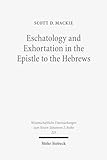Eschatology and exhortation in the Epistle to the Hebrews / Scott D. Mackie. [print]
Material type: TextSeries: Publication details: Tubingen, Germany : Mohr Siebeck, (c)2007.Description: xi, 284 pages ; 24 cmContent type:
TextSeries: Publication details: Tubingen, Germany : Mohr Siebeck, (c)2007.Description: xi, 284 pages ; 24 cmContent type: - text
- unmediated
- volume
- 9783161492150
- 3161492153
- BS2775.M158.E834 2007
- BS2775
- COPYRIGHT NOT covered - Click this link to request copyright permission:
| Item type | Current library | Collection | Call number | Status | Date due | Barcode | |
|---|---|---|---|---|---|---|---|
 Circulating Book (checkout times vary with patron status)
Circulating Book (checkout times vary with patron status)
|
G. Allen Fleece Library CIRCULATING COLLECTION | Non-fiction | BS2775.52.M33.E834 2007 (Browse shelf(Opens below)) | Available | 31923001691001 |
COPYRIGHT NOT covered - Click this link to request copyright permission:
Revision of the author's thesis (Ph. D.)--Fuller Theological Seminary, Pasadena, California, 2006.
The eschatology of Hebrews -- The situation of the recipients -- The author's hortatory response -- Two-age belief in Jewish -- Christian apocalyptic thought and in Hebrews -- An exegetical examination of two-age eschatology in Hebrews -- Cosmology: the setting of the sacrifice and exaltation -- The high priest in the heavenly sanctuary -- The enthroned Son in the heavenly sanctuary.
Scott D. Mackie analyzes the interface of eschatology and exhortation in Hebrews, paying special attention to the manner in which the author's eschatological convictions have shaped and empowered his hortatory effort. The author's eschatological thought-world coheres around two organizing principles: (1) Two-age eschatology: the Christ event has inaugurated the eschaton (9:26) and the end of the ages is imminent (10:26-39); (2) Heavenly Sanctuary eschatology: the Christ event culminates within this heavenly locale (9:11-12, 24; 10:19-21) and it also where the exalted Son reigns (1:3-13; 8:1; 10:12-13). The exhortations appearing in contexts where two-age eschatology is prominent emphasize urgency, immediacy, and existential irrevocability - conditions that naturally evoke calls for steadfast commitment (2:1-3; 3:14; 6:9-12; 10:35-39). Recitations of the community's experience of the eschaton are also prominent in these passages (2:4; 3:14; 6:4-5; 10:26-32). The hortatory agenda accompanying Heavenly Sanctuary eschatology is cultic in nature, focusing on the soteriological benefits of Jesus the high priest's sacrificial self-offering (1:3; 4:16; 5:9; 7:25, 27; 8:6; 9:12, 14-15, 24, 26, 28; 10:10, 12, 14, 18-25, 29). These soteriological benefits are intended to facilitate access to God in the Heavenly Sanctuary. The two exhortations to enter the Heavenly Sanctuary, 4:14-16 and 10:19-23, are then of strategic importance. It is there that the author's ultimate hortatory goal is reached, in the recipients' sacral confession of the Son of God, which forms and solidifies their identity as the family of God (3:1-6, 14; 4:14-16; 10:19-25).
There are no comments on this title.
